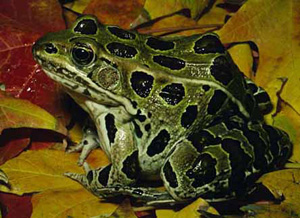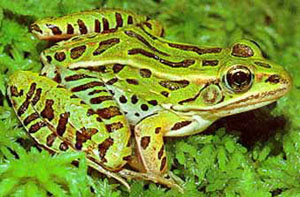Northern Leopard Frog & Southern Leopard Frog
Rana pipiens - Rana sphenocephala
Natives of North America, Leopard frogs are green or greenish brown with creamy white undersides. The back, sides, and legs are dotted with well-defined round dark spots with a light border. Two distinct light-coloured glandular ridges run down the back, from the eyes to the tail. There may also be a light stripe on the upper jaw. Some newly transformed frogs are distinctly brown with black spots and a few individuals, particularly in southern regions, may be quite pale, almost yellow in colour. Occasionally unspotted leopard frogs occur.
Like all true frogs, leopard frogs have smooth moist skin and glandular ridges (dorsolateral folds) that separate the back from the sides of the body (the ridges in leopard frogs form the white lines seen on the back of the frog). The hind legs are long with large feet and well developed webs between the toes.
These frogs can be kept in small groups and are quite active. They are temperate zone reptiles - they do not need special heating zones and can be quite comfortable at room temperature. They are easy to feed, most small insects will do, crickets, mealworms etc. They are suitable for beginners
DO NOT FEED WILD INSECTS OR INSECTS FOUND AROUND THE HOUSE – THEY MAY CARRY DISEASES AND PESTICIDES THAT COULD BE DEADLY TO YOUR PET
Average Size - approximately 3 inches
Life Span - approximately 5-8 years
Diet - crickets, wax worms, fly larvae, and earthworms. learn "how to raise feeder foods"
Feeding - A meal of 3-4 crickets daily is a good starting point, although some experts recommend feeding mature frogs only every other day. Variety seems to be key with frogs - crickets can make up the bulk of the diet but should be supplemented by a variety of other insects and worms. Prey items should be gut loaded (feed nutritious foods such as fruits, vegetables, dog food, fish food etc.) before being given to the frog. Once weekly dust the crickets with a complete reptile vitamin mix.
Housing - A ten gallon tank is sufficient for a single frog (if keeping more frogs the tank size must increase, keeping in mind that floor space is more important than height). Leopard frogs are semi aquatic and need a land area as well as a large enough body of water that they can submerge their bodies.
A half land/half water tank is a good choice for leopard frogs and these can be set up a number of ways It is easiest in the long term to separate the land and water areas with a piece of plastic or Plexiglas placed across the aquarium and sealed with aquarium grade silicone sealant. This allows the use of soil on the terrestrial side to allow the frogs to burrow. A dense piece of wood (e.g. driftwood) can be placed partly in the water and partly on land to provide an easy transition from water to land (this also provides a nice basking spot). Alternately, gravel can be sloped in the aquatic side to provide a ramp out of the water.
Substrate - a combination of soil and peat moss, covered with a commercial reptile bark substrate and sphagnum moss can be used on the terrestrial side. The depth should be at least 2-3 inches to allow  burrowing. Gravel can be used on the aquatic side. It is extremely important to use smooth gravel only (to prevent skin abrasions and injuries), and ideally the gravel should be large enough not to be swallowed. burrowing. Gravel can be used on the aquatic side. It is extremely important to use smooth gravel only (to prevent skin abrasions and injuries), and ideally the gravel should be large enough not to be swallowed.
Temperature - the tank can be kept at room temperature 68-75 F, although a temperature drop at night is a good idea (down to about 60 F).
Lighting - No special lighting is required. You can use a UVA/UVB fluorescent light which may be beneficial. Just make sure the frog can't jump onto the lamp. Avoid making the enclosure too bright however as the frogs may just hide if the tank is very brightly lit. A light cycle of about 10 hours light to 14 hours dark is recommended by some keepers.
Water - the water used must be dechlorinated. Use a product from the pet store designed to remove chorine (and chloramine, if your water supply is treated with chloramine) to be safe. Filtration is not a necessity, but doing a 50% water change on a regular basis (at least twice weekly, perhaps more) is necessary. (In fact, some experts believe that the constant water vibrations from the filter is a sensory overload to frogs).
Recommended Supplies:
- Habitat with secure lid
- Basking rock or log
- Humidity gauge
- Substrate/commercial mulch
- Book about frogs
|
- Canister filter
- Fish net or scoop
- Incandescent light or ceramic heater
- Thermometer
- Vitamin/mineral supplement
| Habitat Maintenance Change at least 1/2 the water twice weekly. Thoroughly clean the tank at least once week: set frog aside in a secure habitat; scrub the tank and furnishings with a 3% bleach solution; rinse thoroughly with water, removing all smell of bleach; dry the tank and furnishings; and add clean substrate
Grooming and Hygiene Don't handle unless necessary; wear latex gloves; do not allow frog's skin to contact with eyes, mouth, or open wounds. Wash your hands after handling the habitat contents to help prevent Salmonella and other infectious diseases.
Signs of a Healthy Pet:
- Active and alert
- Healthy skin
- Clear eyes
|
- Eats regularly
- Clear nose and vent
- Hopping and swimming
| Common Health Issues and Red Flags:
- Lethargy
- Skin lesions
- Loss of appetite
- Distressed breathing
|
- Weight loss
- Weak leg movements
- Bloated abdomen
|
If you notice any of these signs, please contact your exotic animal veterinarian.
As with all pets in this category, it is important that you find a veterinarian that practices in EXOTICS – this is critical. The typical small animal practitioner may not have sufficient knowledge in this area. Even this guide is general in nature and should not be used to diagnose your pet.
|



 burrowing. Gravel can be used on the aquatic side. It is extremely important to use smooth gravel only (to prevent skin abrasions and injuries), and ideally the gravel should be large enough not to be swallowed.
burrowing. Gravel can be used on the aquatic side. It is extremely important to use smooth gravel only (to prevent skin abrasions and injuries), and ideally the gravel should be large enough not to be swallowed.